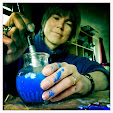When I was invited to spend a week working with RSPB's Project Puffin team last year, I didn't realise that I would have to travel all the way to the most northerly point of the British Isles. And that was only the beginning. The team had assembled in Shetland to monitor an important breeding population of puffins. Every day started with a brisk uphill march of an hour to the colony, carrying heavy scientific equipment, rain coats, warm clothes, climbing gear, and in my case, painting paraphernalia. We had to run the gauntlet of a huge breeding colony of great skuas. In Shetland they're known as Bonxies, for their habit of seeing off any intruders from their territory with a vigorous peck to the head. Luckily the skuas had become used to people on the path, and so as long as we kept to the track we could enjoy seeing the birds at close quarters with their fluffy orange chicks.
Another distraction was all the other rare and exciting birdlife along the walkway. I have never seen
dunlin displaying before, and it was wonderful hearing the snipe performing their drumming display
overhead.
At first, the puffins were not easy to see. We discovered that the number of breeding birds here had declined by more than 90%. Without safety in numbers, puffins would fly in at top speed to avoid the piratical attentions of the Bonxies, and dive into their burrows carrying only a few tiny fish. The Project Puffin team attached tiny GPS trackers to the birds in order to find out where they were fishing, and you can read more about this work in an article that I've written for the Summer 2018 edition of the RSPB’s magazine “Nature’s Home.”
The RSPB lobbies government on matters such as fishing policy and global warming, and scientific data is vital to informing decision-making. Marine ecology is a complicated matter, and although the puffins were really struggling, the gannet colony nearby was booming. Gannets feed on bigger prey like mackerel, and the birds were nesting all the way to the top of the cliffs. This allowed for great sketching opportunities.
By 11pm the midsummer sunset was skimming the horizon. As the Project Puffin team finished work there seemed to be puffins standing all around us on the cliff top. These were younger birds, visiting the colony to meet potential mates and size up nesting burrows for future years. Puffins can live for up to 40 years, and so there’s a chance that data from this project can be used to improve their chances of finding enough fish to raise chicks successfully in the future.
At first, the puffins were not easy to see. We discovered that the number of breeding birds here had declined by more than 90%. Without safety in numbers, puffins would fly in at top speed to avoid the piratical attentions of the Bonxies, and dive into their burrows carrying only a few tiny fish. The Project Puffin team attached tiny GPS trackers to the birds in order to find out where they were fishing, and you can read more about this work in an article that I've written for the Summer 2018 edition of the RSPB’s magazine “Nature’s Home.”
The RSPB lobbies government on matters such as fishing policy and global warming, and scientific data is vital to informing decision-making. Marine ecology is a complicated matter, and although the puffins were really struggling, the gannet colony nearby was booming. Gannets feed on bigger prey like mackerel, and the birds were nesting all the way to the top of the cliffs. This allowed for great sketching opportunities.
By 11pm the midsummer sunset was skimming the horizon. As the Project Puffin team finished work there seemed to be puffins standing all around us on the cliff top. These were younger birds, visiting the colony to meet potential mates and size up nesting burrows for future years. Puffins can live for up to 40 years, and so there’s a chance that data from this project can be used to improve their chances of finding enough fish to raise chicks successfully in the future.





No comments:
Post a Comment